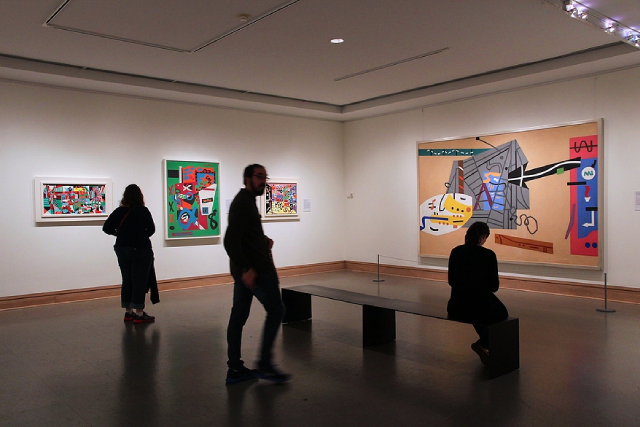The Art Of Exhibition: RFID In Museums And Galleries

Museums and galleries are embracing innovative solutions to enhance the visitor experience and streamline operations. One such groundbreaking technology making waves in the art world is Radio-Frequency Identification (RFID). This cutting-edge system offers a myriad of benefits, revolutionising the way cultural institutions manage their collections and engage with their audience.
Below, we will explore the art of exhibition through the lens of RFID technology and its transformative impact on museums and galleries.
Understanding RFID technology
RFID technology utilises electromagnetic fields to automatically identify and track tags attached to objects. In the context of museums and galleries, these tags can be affixed to artworks, artefacts, or even visitor badges. The RFID system comprises three key components: the RFID tag, the RFID reader, and the database. The tag, equipped with a unique identifier, stores information about the item it is attached to. The reader, powered by radio frequency, detects and captures data from the tags. The database then processes and stores this information, allowing for seamless tracking, monitoring, and management of the items.
Enhancing visitor experience
One of the primary advantages of implementing RFID technology in museums and galleries is its ability to significantly enhance the visitor experience. Traditional methods of exhibition involve static displays and placards, limiting the depth of information provided to patrons. RFID tags enable a dynamic and interactive experience by offering in-depth details about each exhibit. Visitors can simply wave their RFID-enabled badges or smartphones near the tag, instantly accessing multimedia content, historical context, and even artist interviews related to the displayed items.
Moreover, RFID enhances accessibility for individuals with special needs. Customised content delivery and guided tours can be tailored to meet specific requirements, ensuring an inclusive and enriching experience for all visitors. This level of personalization creates a deeper connection between the audience and the exhibits, fostering a greater appreciation for art and culture.
Efficient collection management
Beyond improving the visitor experience, RFID technology revolutionises the way museums and galleries manage their collections. Traditionally, cataloguing and tracking artefacts involve tedious manual processes, leaving ample room for errors and inefficiencies. RFID automates these tasks, providing a real-time, accurate, and comprehensive inventory management system.
By tagging each item with RFID, museums can easily track the movement of artefacts within the institution, monitor their condition, and streamline the loan process for temporary exhibitions. This not only reduces the risk of theft or mishandling but also expedites the curatorial workflow, allowing staff to focus on creating compelling narratives and curating engaging exhibitions.
Enhanced security measures
Preserving the integrity of artworks and artefacts is a top priority for museums and galleries. RFID technology contributes to enhanced security measures by acting as a powerful deterrent to theft and unauthorised handling. Each tagged item is registered in the database, creating a digital fingerprint that can be traced back to its origin. In the event of a security breach, the RFID system can quickly identify missing items, aiding in the recovery process and discouraging potential thieves.
Furthermore, RFID technology allows museums to implement access control systems, restricting entry to designated personnel during off-hours or limiting access to specific storage areas. This ensures that valuable and sensitive pieces are safeguarded against potential risks, contributing to the long-term preservation of cultural heritage.
Streamlined operations and analytics
The implementation of RFID technology not only improves security and visitor experiences but also streamlines the overall operations of museums and galleries. RFID-enabled systems automate mundane tasks such as inventory tracking, reducing the burden on staff and freeing up resources for more strategic initiatives.
In addition to operational efficiency, RFID technology provides valuable data insights through analytics. Museums can analyse visitor flow, exhibit popularity, and engagement levels, helping them make informed decisions about exhibit placement, content development, and marketing strategies. This data-driven approach enables cultural institutions to adapt and evolve, ensuring they remain relevant and appealing to their diverse audiences.
The green advantage
As sustainability becomes a focal point for institutions worldwide, RFID technology offers a sustainable and an eco-friendly alternative to traditional exhibition methods. The shift towards digital information delivery reduces the need for printed materials, such as brochures and signage, minimising the environmental impact of exhibitions. RFID also facilitates efficient energy management, contributing to the overall sustainability goals of museums and galleries.
Conclusion
The art of exhibition is undergoing a transformative journey with the integration of RFID technology in museums and galleries. From enhancing visitor experiences and streamlining operations to fortifying security measures and promoting sustainability, RFID is redefining the way cultural institutions engage with their audiences and manage their collections. As we witness this technological revolution unfold, it is evident that this asset tracking system has become an indispensable tool in the curator’s arsenal, shaping the future of the art world.